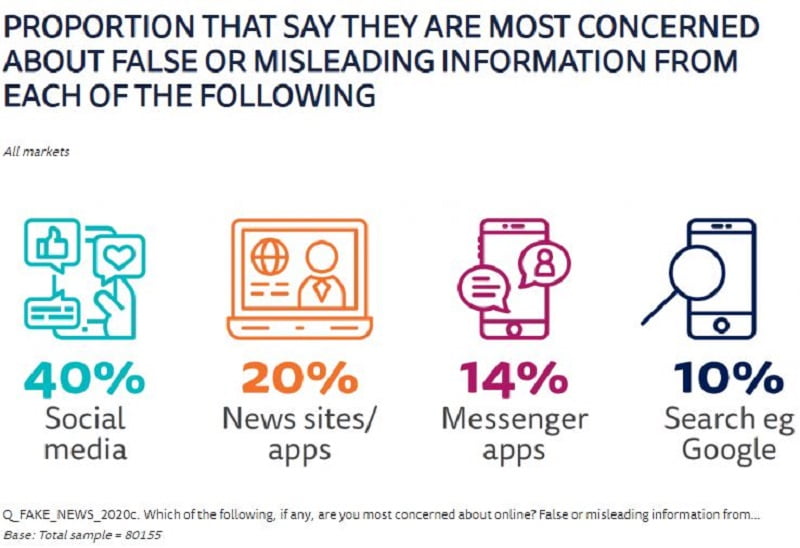Facebook and messaging apps such as Messenger and WhatsApp are seen to be the biggest channel through which misinformation and fake news is spread – especially during the coronavirus pandemic, according to a report.
In fact, social media across the board was the biggest source of concern about misinformation (40%), well ahead of news sites (20%), messaging apps like WhatsApp (14%), and search engines such as Google (10%).
The 2020 Reuters Institute Digital News Report found that, overall, 29 per cent are most concerned about Facebook while 35 per cent of respondents from countries from the south – such as Brazil, for example – said they were concerned about closed messaging apps such like WhatsApp.

Source: 2020 Reuters Digital News Report.
However, in Philippines (47%) and the United States (35%), the overwhelming concern is about Facebook, with other networks playing a minor role while Twitter is seen to be the biggest problem in Japan and YouTube in South Korea.
The annual survey on digital news consumption was based on 80,000 consumers in 40 countries and examined the impact of coronavirus on news consumption and on economic prospects for publishers.
It also looked at new paid online business models, trust and misinformation, partisanship and populism, and the popularity of new curated editorial products like podcasts and email newsletters.
Nic Newman, a Senior Research Associate at the Reuters Institute for the Study of Journalism, pointed out that this year’s report came in the midst of an unprecedented global health pandemic whose economic, political, and social consequences were still unfolding. “The seriousness of this crisis has reinforced the need for reliable, accurate journalism that can inform and educate populations, but it has also reminded us how open we have become to conspiracies and misinformation,” he said.
Journalists no longer control access to information, while greater reliance on social media and other platforms gave people access to a wider range of sources and ‘alternative facts’, some of which are at odds with official advice, misleading, or simply false.
In fact, the report found that the coronavirus crisis substantially increased news consumption for mainstream media. More people watched television news broadcasts, identifying it as their main source of news, “providing temporary respite from a picture of steady decline”.
Printed newspapers were affected negatively due to the lockdown across countries, which made physical distribution difficult. Meanwhile, the use of online and social media substantially increased in most countries. WhatsApp saw the biggest growth in general with increases of around ten percentage points in some countries, while more than half of those surveyed (51%) used some kind of open or closed online group to connect, share information, or take part in a local support network.
Read the report in full here.













